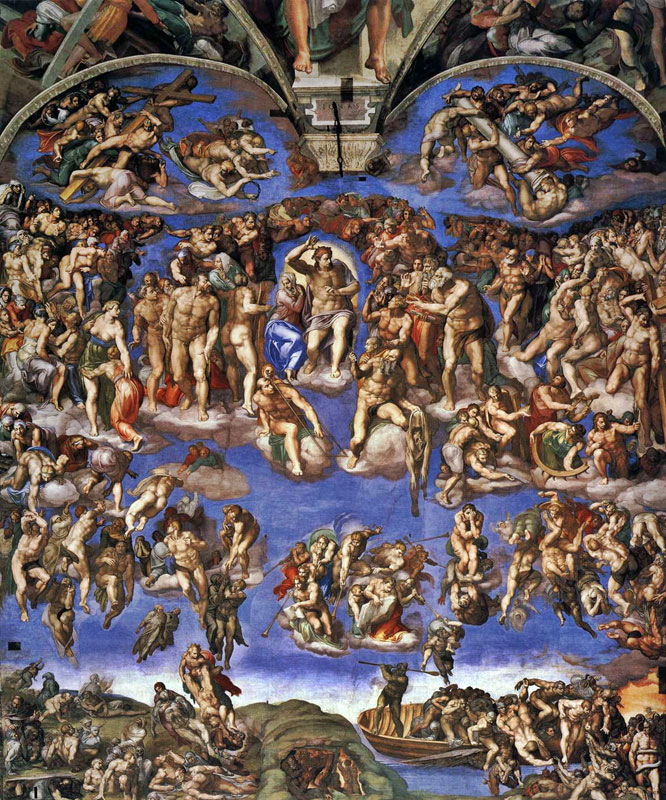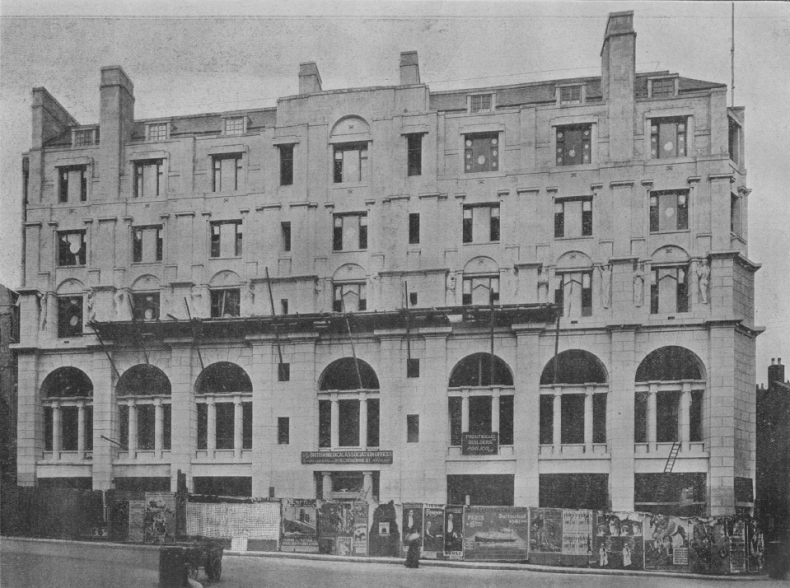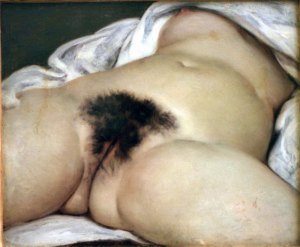Last week, Fox 5 News decided that the American people needed protecting from the brazen nudity of Les Femmes d’Alger (Version ‘O’). New York’s Fox affiliate channel was reporting on the record-breaking price ($179.4 mllion) that Picasso’s painting had fetched at Christie’s in its Monday evening sale, ‘Looking forward to the Past’. The most expensive work of art ever sold at auction was presented to the world with smudgy veils hovering over three sets of abstract, painted, yet apparently offensive breasts. (The bare bum in the centre of the image was fine though).
By stepping in to shield New York’s eyes and minds, Fox 5 News was joining in a long and ignoble tradition of censoring works of art. Which other masterpieces have been deemed indecent over the years?
Michelangelo’s The Last Judgement (1536–41)
In the Last Judgement men and women, saints and sinners, young and old, are naked before the eyes of God – but no longer before the eyes of visitors to the Sistine Chapel. Michelangelo’s composition of writhing, muscular nudes faced criticism from the start: Vasari recorded that the Papal Master of Ceremonies, Biagio da Cesena, thought The Last Judgement ‘was not a work for a Chapel of the Pope but for stoves and taverns’ when it was unveiled at the Vatican. In 1564, some of the most ‘obscene’ figures were painted over with drapery by Daniele da Volterra, known afterwards as the il braghettone (the breeches maker). More cover-ups were apparently added in subsequent decades – and several were left in place when the painting was restored in the 1990s.

The Last Judgement (1536–41), Michelangelo. Image source: Wikimedia Commons (Sailko)
Michelangelo’s David (1501–1504)
Apparently Queen Victoria concurred with the view that Michelangelo’s nudes were too naked. When she was presented with a plaster cast of the artist’s masterpiece by the Grand Duke of Tuscany in 1857 she had a huge plaster-cast fig leaf made to preserve his modesty. The statue was housed in the newly opened Victoria and Albert Museum. For years, David would don his fig leaf during royal visits, but these days it’s kept tucked away behind him as a memento.
Jacob Epstein’s British Medical Association reliefs (1908)
In 1908 Jacob Epstein was commissioned to create a series of sculptures representing the ages of man for the British Medical Association building on the Strand. His creations caused the first of many controversies that came to characterise the modernist sculptor’s career. Affronted by Epstein’s unidealised depiction of an old woman and unapologetically frontal depiction of a naked man, conservative critics condemned the scheme as indecent. It remained in place nonetheless, until the Rhodesian High Commission bought the building 30 years later. Using the deterioration of the Portland stone as an excuse, the new owners had the statues hacked out of the scheme: you can still see the defaced remains on the building, which is now known as Zimbabwe House.

The British Medical Association building (now Zimbabwe House), The Strand, London, by Charles Holden with sculptures by Jacob Epstein (later destroyed). Agar Street elevation, under construction. Image source: Wikimedia Commons
Giambattista Tiepolo’s The Truth Unveiled by Time (1744)
In 2008, Silvio Berlusconi – by all accounts a most unlikely prude – dismayed art lovers by tinkering with Tiepolo’s version of Truth. A reproduction of the baroque artist’s work formed the backdrop for the Italian Prime Minister’s press room, but it had one unexpected addition – a thin layer of fabric drawn up over the female figure’s bare breast. Apparently the image was retouched because his advisers thought it would distract viewers during his TV addresses.
Gustave Courbet’s L’Origine du monde (1866)

L’Origine du Monde (1866), Gustave Courbet
The realist painter Gustave Courbet’s controversial depiction of ‘the origin of the world’ fell foul of Facebook’s nudity rules recently and sparked a legal battle in France. A schoolteacher, who had posted an image of the work with a link through to a video about its history, sued the company for damages after his account was suspended. Fervent debate about the role of censors in social media and the line between pornography and art ensued – much of it on Facebook itself. The company eventually restored the teacher’s account (without the offending image) and issued an apology.

Avert your Eyes: Censored Art Masterpieces
picasso-mainimage One 'Les Femmes d’Alger (Version O)' by Picasso will get you... (Image: Christie's)
Share
Last week, Fox 5 News decided that the American people needed protecting from the brazen nudity of Les Femmes d’Alger (Version ‘O’). New York’s Fox affiliate channel was reporting on the record-breaking price ($179.4 mllion) that Picasso’s painting had fetched at Christie’s in its Monday evening sale, ‘Looking forward to the Past’. The most expensive work of art ever sold at auction was presented to the world with smudgy veils hovering over three sets of abstract, painted, yet apparently offensive breasts. (The bare bum in the centre of the image was fine though).
By stepping in to shield New York’s eyes and minds, Fox 5 News was joining in a long and ignoble tradition of censoring works of art. Which other masterpieces have been deemed indecent over the years?
Michelangelo’s The Last Judgement (1536–41)
In the Last Judgement men and women, saints and sinners, young and old, are naked before the eyes of God – but no longer before the eyes of visitors to the Sistine Chapel. Michelangelo’s composition of writhing, muscular nudes faced criticism from the start: Vasari recorded that the Papal Master of Ceremonies, Biagio da Cesena, thought The Last Judgement ‘was not a work for a Chapel of the Pope but for stoves and taverns’ when it was unveiled at the Vatican. In 1564, some of the most ‘obscene’ figures were painted over with drapery by Daniele da Volterra, known afterwards as the il braghettone (the breeches maker). More cover-ups were apparently added in subsequent decades – and several were left in place when the painting was restored in the 1990s.
The Last Judgement (1536–41), Michelangelo. Image source: Wikimedia Commons (Sailko)
Michelangelo’s David (1501–1504)
Apparently Queen Victoria concurred with the view that Michelangelo’s nudes were too naked. When she was presented with a plaster cast of the artist’s masterpiece by the Grand Duke of Tuscany in 1857 she had a huge plaster-cast fig leaf made to preserve his modesty. The statue was housed in the newly opened Victoria and Albert Museum. For years, David would don his fig leaf during royal visits, but these days it’s kept tucked away behind him as a memento.
Jacob Epstein’s British Medical Association reliefs (1908)
In 1908 Jacob Epstein was commissioned to create a series of sculptures representing the ages of man for the British Medical Association building on the Strand. His creations caused the first of many controversies that came to characterise the modernist sculptor’s career. Affronted by Epstein’s unidealised depiction of an old woman and unapologetically frontal depiction of a naked man, conservative critics condemned the scheme as indecent. It remained in place nonetheless, until the Rhodesian High Commission bought the building 30 years later. Using the deterioration of the Portland stone as an excuse, the new owners had the statues hacked out of the scheme: you can still see the defaced remains on the building, which is now known as Zimbabwe House.
The British Medical Association building (now Zimbabwe House), The Strand, London, by Charles Holden with sculptures by Jacob Epstein (later destroyed). Agar Street elevation, under construction. Image source: Wikimedia Commons
Giambattista Tiepolo’s The Truth Unveiled by Time (1744)
In 2008, Silvio Berlusconi – by all accounts a most unlikely prude – dismayed art lovers by tinkering with Tiepolo’s version of Truth. A reproduction of the baroque artist’s work formed the backdrop for the Italian Prime Minister’s press room, but it had one unexpected addition – a thin layer of fabric drawn up over the female figure’s bare breast. Apparently the image was retouched because his advisers thought it would distract viewers during his TV addresses.
Gustave Courbet’s L’Origine du monde (1866)
L’Origine du Monde (1866), Gustave Courbet
The realist painter Gustave Courbet’s controversial depiction of ‘the origin of the world’ fell foul of Facebook’s nudity rules recently and sparked a legal battle in France. A schoolteacher, who had posted an image of the work with a link through to a video about its history, sued the company for damages after his account was suspended. Fervent debate about the role of censors in social media and the line between pornography and art ensued – much of it on Facebook itself. The company eventually restored the teacher’s account (without the offending image) and issued an apology.
Unlimited access from just $16 every 3 months
Subscribe to get unlimited and exclusive access to the top art stories, interviews and exhibition reviews.
Share
Recommended for you
Art Outlook
Fears for Palmyra as Islamic State militants seize neighbouring town; Anne Pasternak takes over at the Brooklyn Museum; Abramovic and Jay Z have a very public spat
Selling the collection to save the house: Russborough and Irish heritage
Ireland should be more concerned over the dispersal of its cultural heritage
London Diary
Hockney’s psychedelic new creations at Annely Juda; Thomas Struth’s exceptional photographs at Marian Goodman; and Andre Kertesz at James Hyman